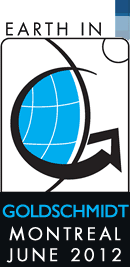Features
Dates & Deadlines
April 20
Early-bird registration deadline
June 1
Hotel reservations
June 11
Online Registration closes
The call for abstracts is now closed.
Themes
Sessions & Descriptions
| < Previous Theme | Theme Overview | Next Theme > |
Theme 18
Frontiers in Computational Geochemistry
Stephen C. Parker, Bath,
Kevin Rosso, PNNL,
SESSIONS
18a. Molecular model development and simulation of geologic aqueous environments: from magmatic waters to chlatrate hydrates
Co-convenors:
Ariel A. Chialvo (Oak Ridge National Laboratory) - chialvoaa![]() ornl.gov
ornl.gov
Sandro Jahn (GFZ German Research Centre for Geosciences Potsdam) - jahn![]() gfz-potsdam.de
gfz-potsdam.de
Aqueous environments are commonplace in nature involving mineral deposition, volcanic eruptions, hydrothermal vents, geysers, sedimentary brines and gas chlatrate hydrates. These natural processes as well as geologic engineering such as geothermal energy development and geologic CO2 capture/sequestration, involve aqueous fluids under diverse environments and reactivity. These systems are typically not easily accessible experimentally, i.e., the microstructural, thermophysical, and thermochemical interpretation of relevant geochemical processes taking place in those environments cannot be readily achieved. Recent advances in computational power and algorithm development have made possible their study by molecular based approaches, whose reliability depends on the ability of the molecular interaction models (ab initio or classical force fields) to capture the relevant physico-chemistry of aqueous systems in geologic environments. Appropriate force-fields require the explicit account of polarization and reactivity, to be able to cover the wide range of state conditions, composition, and the unavoidable presence of (fluid-fluid and solid-fluid) interfaces and confinement. A key theme of this session is the development of new, and adaptation of current force-fields, their parameterization and validation, for the simulation of geo-fluids and their interactions with minerals at the above geologic environments. Therefore, this session will encourage contributions involving classical, reactive, and ab initio simulations involving their interplay with experiment aimed at understanding the microstructure and dynamics of these complex systems.
Keynote speaker:
Andras Baranyai (Institute of Chemistry - Eötvös University, Budapest), bajtony![]() chem.elte.hu
chem.elte.hu
Invited speakers:
Paolo Raiteri (Curtin University, Perth, Australia), p.raiteri![]() curtin.edu.au
curtin.edu.au
William R. Smith (University of Ontario, Canada, william.smith![]() uoit.ca
uoit.ca
Lukas Vlcek (Oak Ridge National Laboratory, U.S.A, vlcekl1![]() ornl.gov
ornl.gov
Rodolphe Vuilleumier (UMR 8640, CNRS-ENS-UPMC, Paris) Rodolphe.Vuilleumier![]() ens.fr
ens.fr
18b. Nucleation, growth, and dissolution in aqueous environments: Elementary processes and atomistic models
(co-hosted by Themes 18 and 19)
Co-convenors:
Paolo Raiteri (Curtin University, Australia) - p.raiteri![]() curtin.edu.au
curtin.edu.au
Raffaella Demichelis (Curtin University, Australia) - raffaella![]() ivec.org
ivec.org
Sebastien Kerisit (Pacific Northwest National Laboratory) - sebastien.kerisit![]() pnl.gov
pnl.gov
Due to the intrinsic dynamical nature of many aqueous geochemical environments, minerals often found themselves in a race to reach equilibrium via nucleation, growth, and dissolution processes. At their core, growth and dissolution consist in the attachment and detachment of atomic or molecular blocks. Importantly, such processes are central to many environmental challenges facing us today such as nuclear waste disposal, geological carbon dioxide sequestration, and contaminant remediation. Therefore, there is a tremendous interdisciplinary interest in developing an atomic-level knowledge of the elementary mechanisms underlying nucleation, growth, and dissolution. Although much progress has been made to date, understanding these phenomena remains an important fundamental problem.
This session will highlight recent progress based on experimental research and computational studies in the development of atomistic models of mineral nucleation, growth, and dissolution. Due to the time scales involved, using computer simulations to model the kinetics of these processes is a challenge to traditional molecular simulation techniques. Therefore, this session also invites presentations on the development and application of theoretical methods that can extend the time scales reachable with common techniques. Many naturally-occurring solids are not crystalline or are not initially nucleated as crystalline phases. Therefore, this session also invites researchers with interest in the dissolution of amorphous solids and the role of amorphous phases in crystal nucleation.
Keynote speaker:
Michele Parrinello (ETH Zurich), parrinello![]() phys.chem.ethz.ch
phys.chem.ethz.ch
18c. Computer simulations of silicate liquids and glasses
(co-hosted by Themes 18, 3 and 6)
Co-convenors:
Bijaya B Karki (Louisiana State University) - karki![]() csc.lsu.edu
csc.lsu.edu
Renata Wentzcovitch (University of Minnesota) - wentz002![]() umn.edu
umn.edu
CANCELLED
18d. Computational challenges to unravelling the geochemistry of sulfide minerals
Co-convenors:
Nora de Leeuw (University College London, UK) - n.h.deleeuw![]() ucl.ac.uk
ucl.ac.uk
Liane Benning (University of Leeds, UK) - l.g.benning![]() leeds.ac.uk
leeds.ac.uk
Mariette Wolthers (University of Utrecht, Netherlands) - M.Wolthers![]() uu.nl
uu.nl
CANCELLED
Co-hosted sessions:
Please note that for abstract submission purposes, the following sessions and their respective descriptions appear in their primary Theme assignments (numbers in red or before the title).
- 8a.-Mineral growth and dissolution: modern approaches to molecular-level reaction mechanism determination with implications for toxic metal sequestration, biomineralization, and engineering.
- Co-convenors: Andrew Stack/Oak Ridge, Steve Higgins/Wright State and Frank Heberling/Karlsruhe Institute of Technology
(co-hosted by Themes 8, 18 and 19) - 8f.- Inorganic redox processes at mineral surfaces and nanoparticles
- Co-convenors: Udo Becker/Michigan, Devon Renock/Dartmouth College and Kevin Rosso/PNNL
(co-hosted by Themes 8 and 18) - 8g.- Structure and dynamics of ions and water at mineral-water interfaces: insights from experimental and computational studies
- Co-convenors: Sang Soo Lee/Argonne National Laboratory, Man Xu/Wright State University and Louise J. Criscenti/Sandia National Laboratories
(co-hosted by Themes 8 and 18) - 8h.- Surface complexation modeling: contemporary challenges and opportunities
- Co-convenors: James A. Davis/Lawrence Berkeley, Michael L. Machesky/University of Illinois and Willem H. van Riemsdijk/Wageningen University
(co-hosted by Themes 8 and 18)




